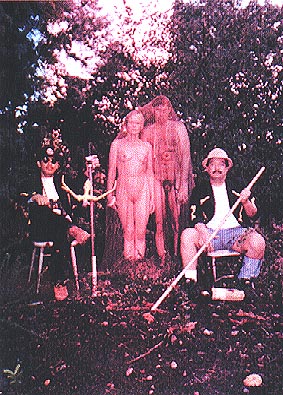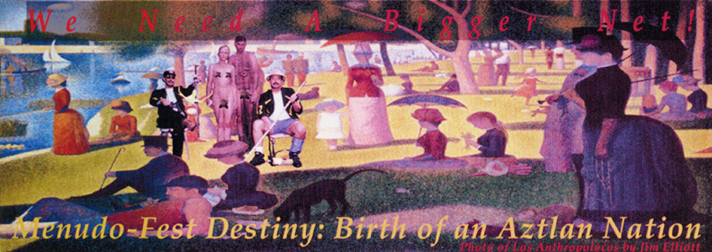

| For more information about this article or gallery, please call the gallery phone number listed in the last line of the article, "For more info..." |
September Issue 2003
USC-Sumter in Sumter, SC, Features Works by Robert J. Sanchez and Richard A. Lou
The University of South Carolina at Sumter in participation with Accessibility 2003, will showcase installation artists Robert J. Sanchez from San Diego, CA, and Richard A. Lou from Milledgeville, GA. Their exhibit titled Los Anthropolocos will be on display in the University Gallery which is located in the Anderson Library Gallery in Sumter, SC. This exhibit will run from Sept. 26 through Nov. 26, 2003. Both artists will be in residence for the opening of the exhibit and a gallery talk is scheduled for Sept. 26, from 6-8pm.
The following is an artists' statement about their work:
 "color photo
of Robert Sanchez and I examining colorless artifact - B. Manilow"
"color photo
of Robert Sanchez and I examining colorless artifact - B. Manilow"
Dig Site #7AAA3476 - Actual photographs of dig site in East County San Diego being excavated by Los Anthropolocos. Unearthing artifacts from white culture such as the Manilow LP: ARTIFACT #12897 - vinyl and cardboard. Found with the Shroud of El Cajon. This was found in the East County of Califas near Duke's Transmission Repair. The colorless always buried their dead near transmission shops. The Shroud was used to completely wrap the mummified remains of the colorless specimen into a cocoon like physical state.
Los Anthropolocos is an ongoing fictional narrative about the exploits of two futuristic Chicano anthropologists/archaeologists, Dr. Ritchie A. Lou and Dr. Bobby J. Sanchez, who discover and study white ethnicity. The Colorless Empire (Caucasians) is believed to be extinct and in its stead is the triumphant Chicano nation of United Aztlan. Using what one would consider the Swiftian model of parody and satire, we as Los Anthropolocos, dismantle the System from the usual players, in which, the "normal" relationships of power are reversed. Instead of Caucasian anthropologists perusing and ascribing meaning to the remains of some exotic culture, Chicano anthropologists, operating within the same parameters of scientific inquiry and, of course, the expressed authority of the status quo, peruse and declare meaning to the remains of the white race or as we have coined "them", the "colorless."
Outside the zany and absurd antics of Los Anthropolocos is the paralleling that occurs within both the fictional narrative and the real. What occurs in the system is examined without the tacit approval of "who" is doing the defining? Chicanos are the dominant culture with the authority to display, define and thus control. The colorless as a culture becomes a benchmark from which the chicano elite can claim a more evolved and civilized population. The dehumanization process as a system, as an institution becomes evident. The artwork examines both communities use of images and language to dehumanize "outsiders" in order to ignore the "outsiders" basic human rights. It challenges unquestioned claims to territory and legal status. The artwork cannot be dissected from the history of our chicano community. As chicanos we cannot escape the fact that we live in occupied territory and that we are the subjugated. We are inculcated on these matters on a daily basis, 24 hours a day, as real lived and relived experiences.

(color photo of Robert Sanchez and I with
two netted colorless)
Captives of Fate - After capturing and tranquilizing these two
magnificent specimen Los Anthropolocos were overcome by a combination
of euphoria and grief. They understood the importance of being
privileged, figuratively, to travel back to some unspeakable primordial
place. To see and touch ones past is frightening. Los Anthropolocos
walked the Mountains of the West, just north of Whittier, grieving,
tormented and forlorn. Had they reached the end of their life
work, searching for and analyzing the colorless? And what will
become of these godless brutes? Will they be capable of learning
a language beyond their customary grunt squeals and belches? These
questions caromed off the left banks of their collective minds.
As with lightning and thunder there was a great burst of energy
and light, then silence. The Captives of Fate World Tour was born.
Los Anthropolocos would begin their travel with the two specimens,
to all major cities in United Aztlan and the world recreating
a live dramatic reinterpretation of the capture of the Colorless.
A handsome publication (with a 150 frame-able color plates) would
coincide with the interpretive reenactment tour on the talk show
circuit: Late Night with Ted Briseno, Chatting with Charro, It's
the Olmos Morning Show, Ondas con Handro, Good Morning Aztlan
and the Coco Fusco Hour.
Whitefying - Sanchez and Lou explore issues of "white" ethnicity by using the same anthropological and archeological techniques used by the "dominant culture" to support their claims about race, culture, ethnicity, and primitivism. Lou and Sanchez investigate how the "dominant culture" perceives the remains of people of color as exotic artifacts to be examined, probed, classified, and displayed for public consumption, and for the public's participation in the codification of the difference between the sub-human "other" and the self-imposed superiority of western civilization. This in turn legitimizes the practice of intrusion, destruction, and display. The notions of scientific inquiry, and its mantle of objectivity, have justified hundreds of years of violently unearthing the "other" to satisfy euro-knowledge. Scientific inquiry or western rational thought overrides the sacredness of ceremony and ritual, which facilitates the community's understanding of life and the after life and the bridge between. The "other's" cultural practices and belief systems are deemed quaint and irrelevant, on one hand, yet important as a gauge of western civilizations social and technological advancement, on the other. Even in death people of color are forced to accommodate the dominant culture's need for a safe dark safari. Western museums have become giant de-contextualized mausoleums, physically warehousing and spiritually suspending in perpetuity our ancestor's final destination as prescribed by their beliefs.
As young graduate students Los Anthropolocos (Drs. Lou and Sanchez) would take the city bus, shovel and picks in hand, to their secret dig site and would excavate all summer long lost in the sweetness of science and discovery. Their notoriety growing with each and every mummy discovered they finally received the recognition they so richly deserved and yearned. In 2050 the Doctors (they weren't known as Los Anthropolocos until their major find of 2057 when they had unearthed the actor/politician Pauley Shore) received their first major grant from the Pioneer Foundation totaling $1.3 million. This grant enabled them to organize a major dig site. This dig was one of their most successful yielding over 15,000 white mummies. This created quite a stir when trucks filled with white remains would drive through towns and villages on their way to their final resting-place in the University of Aztlan Anthropology Museum. Continuing in their unnatural and often criticized studies on "white" ethnicity they were to achieve their greatest discovery, the discovery of the lost "colorless". This was to catapult them to become the rock stars of science.
For more information on this exhibit check our SC Institutional Gallery listings, contact either Professor Cara-lin Getty, USC Sumter's director of galleries and curator of exhibits, by calling 803/938-3727, or Laura Cardello, galleries and exhibits assistant, at 803/938-3858 weekdays.
For more information on the artist Richard A. Lou, click here.
Carolina Arts is published monthly by Shoestring Publishing
Company, a subsidiary of PSMG, Inc.
Copyright© 2003 by PSMG, Inc., which published Charleston
Arts from July 1987 - Dec. 1994 and South Carolina Arts
from Jan. 1995 - Dec. 1996. It also publishes Carolina Arts
Online, Copyright© 2003 by PSMG, Inc. All rights reserved
by PSMG, Inc. or by the authors of articles. Reproduction or use
without written permission is strictly prohibited. Carolina
Arts is available throughout North & South Carolina.